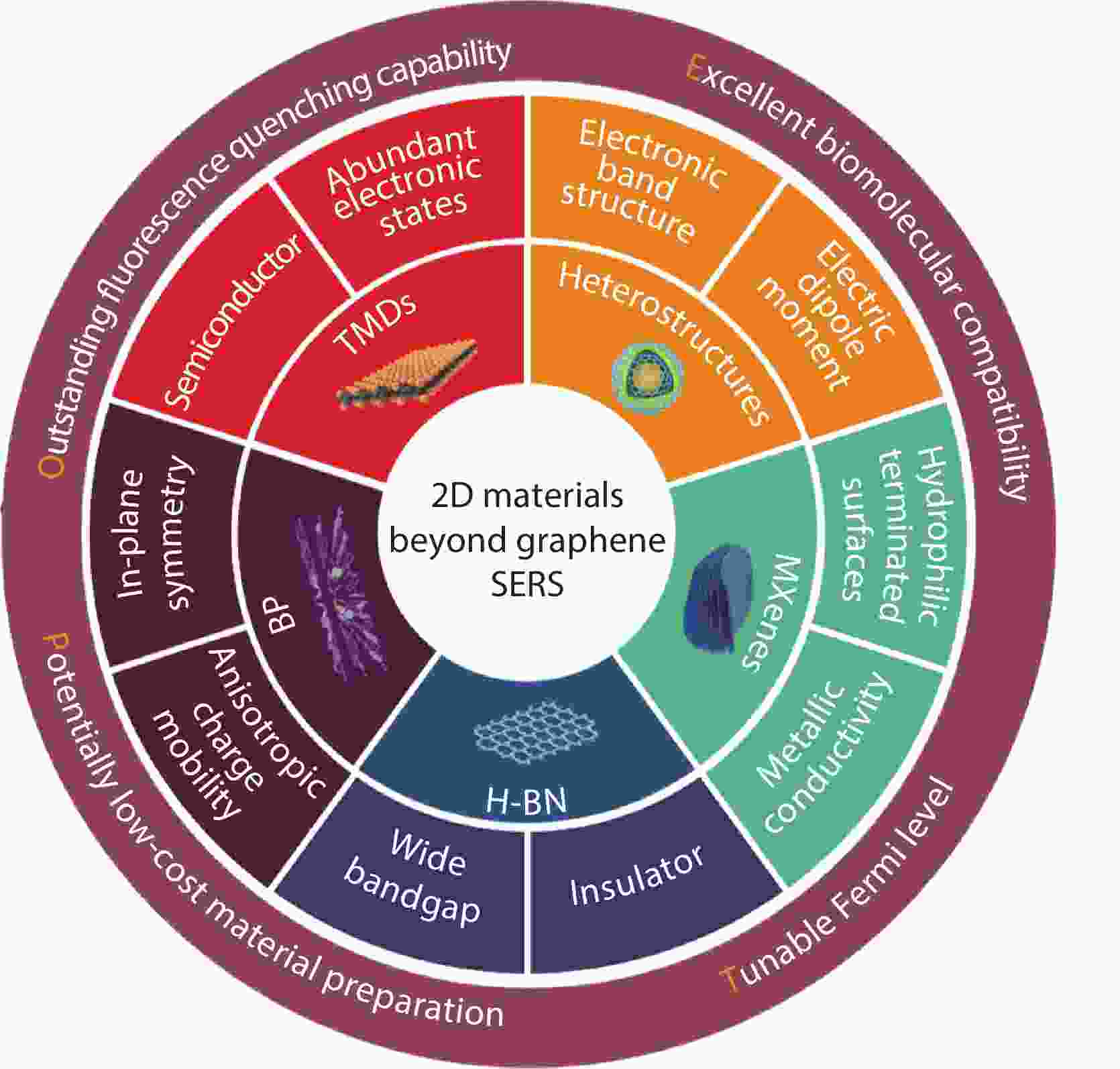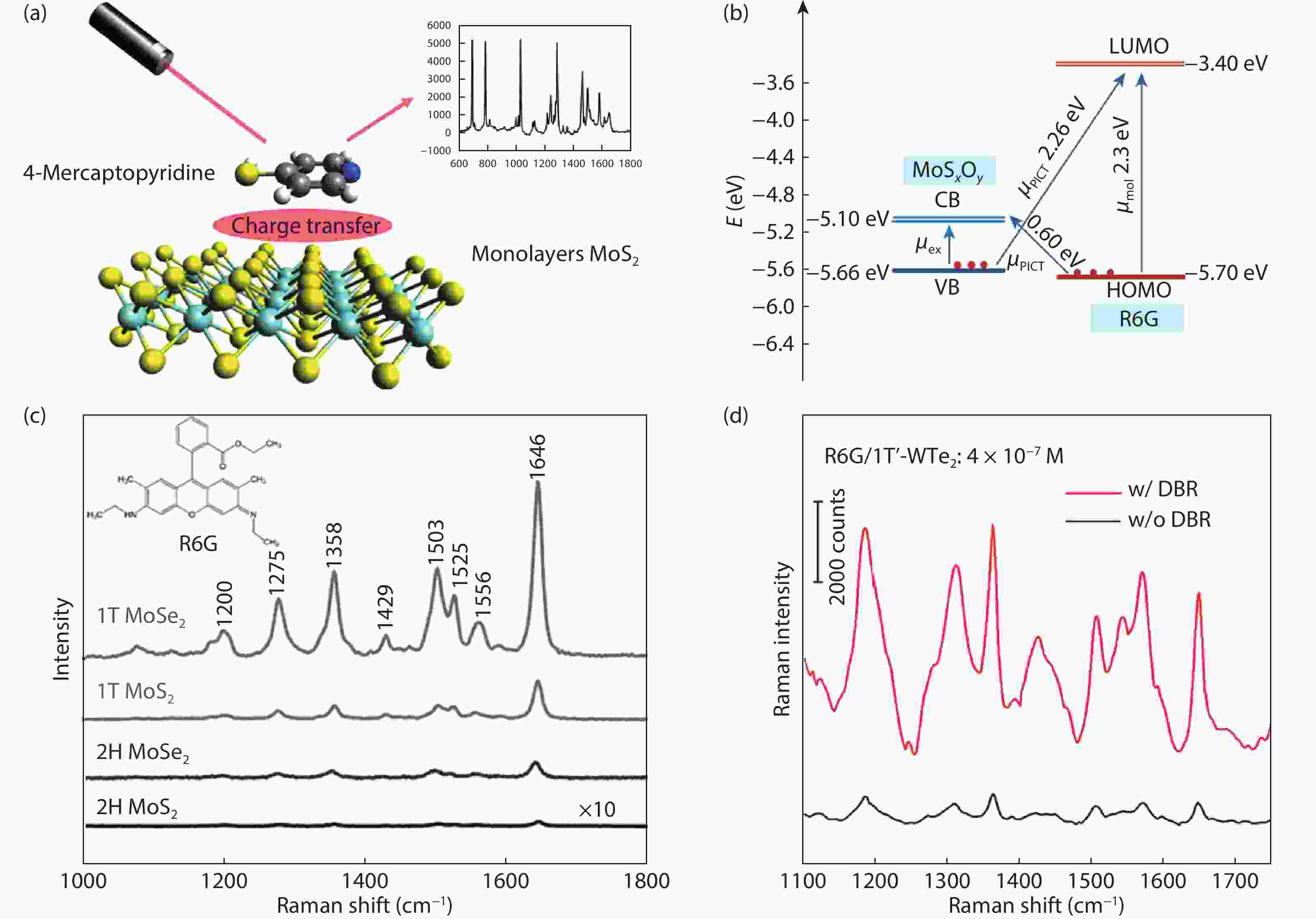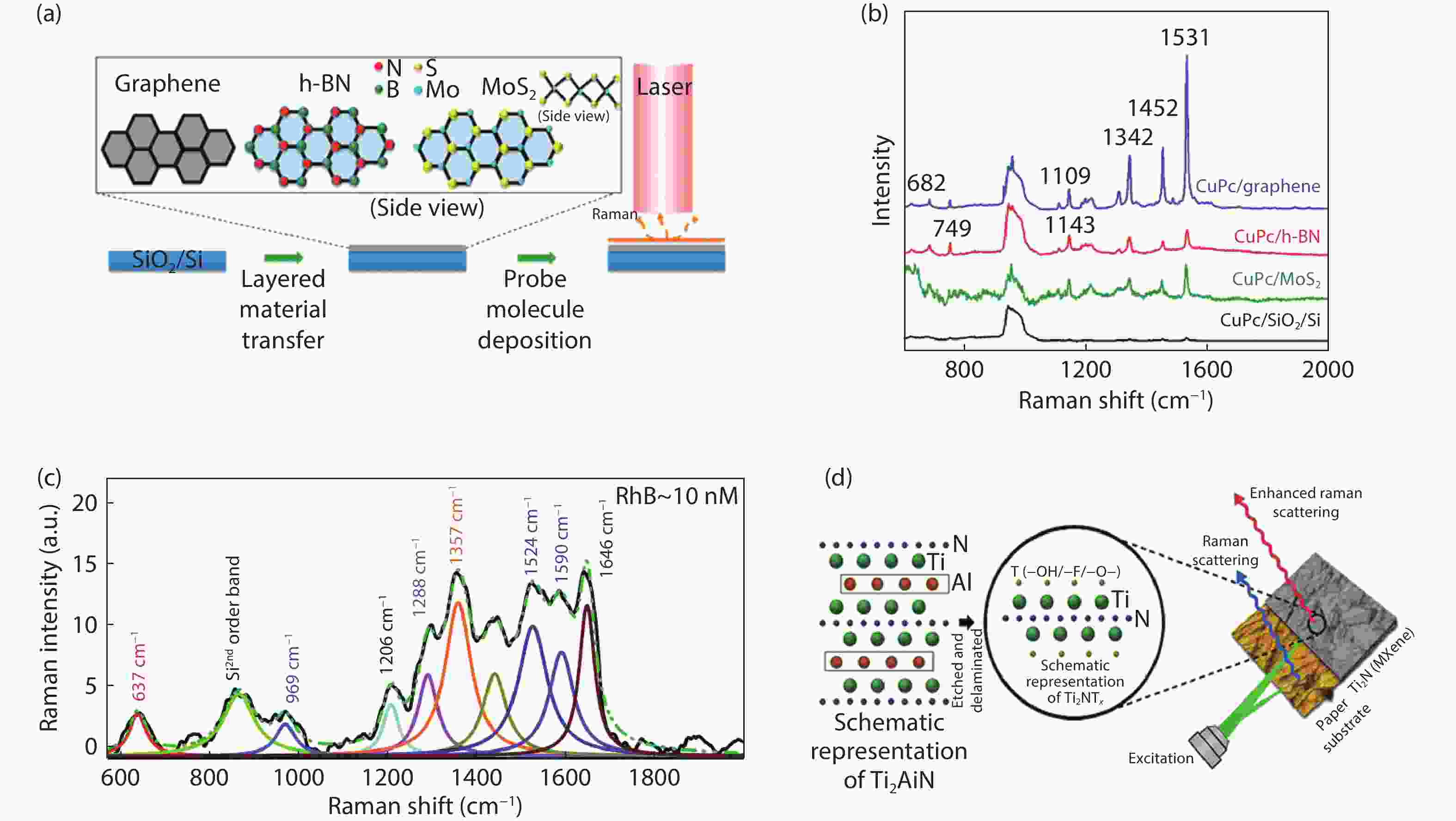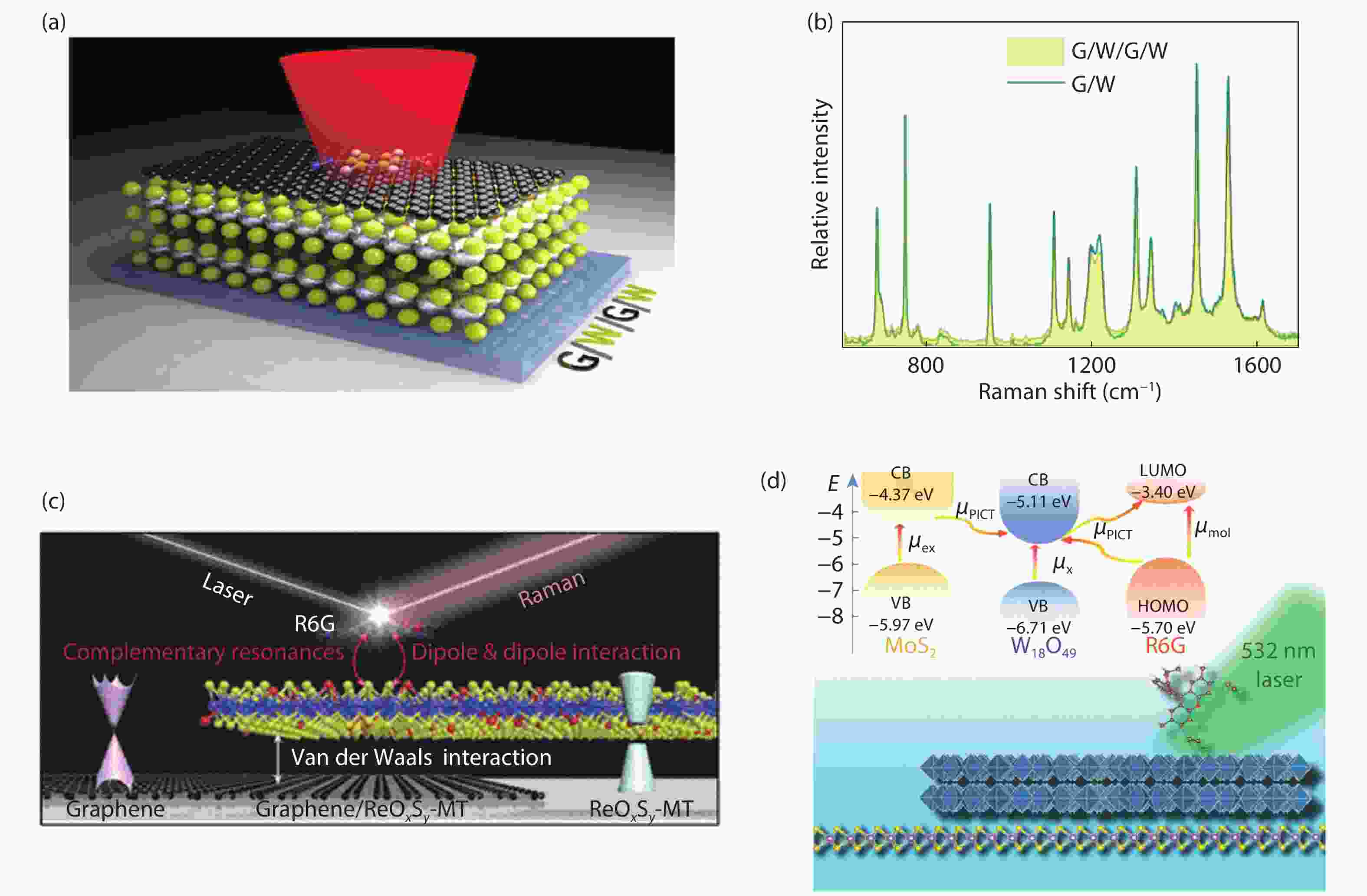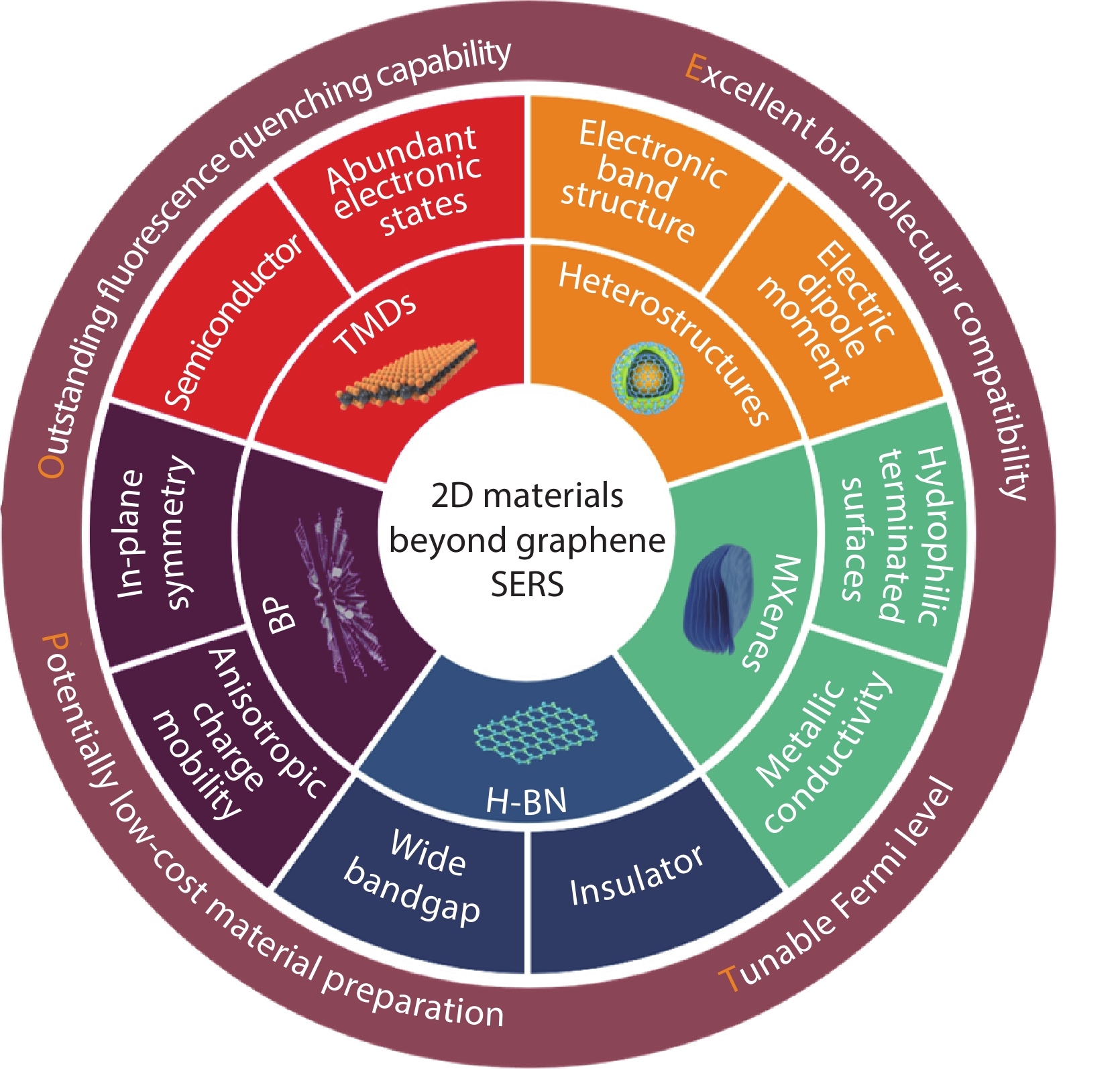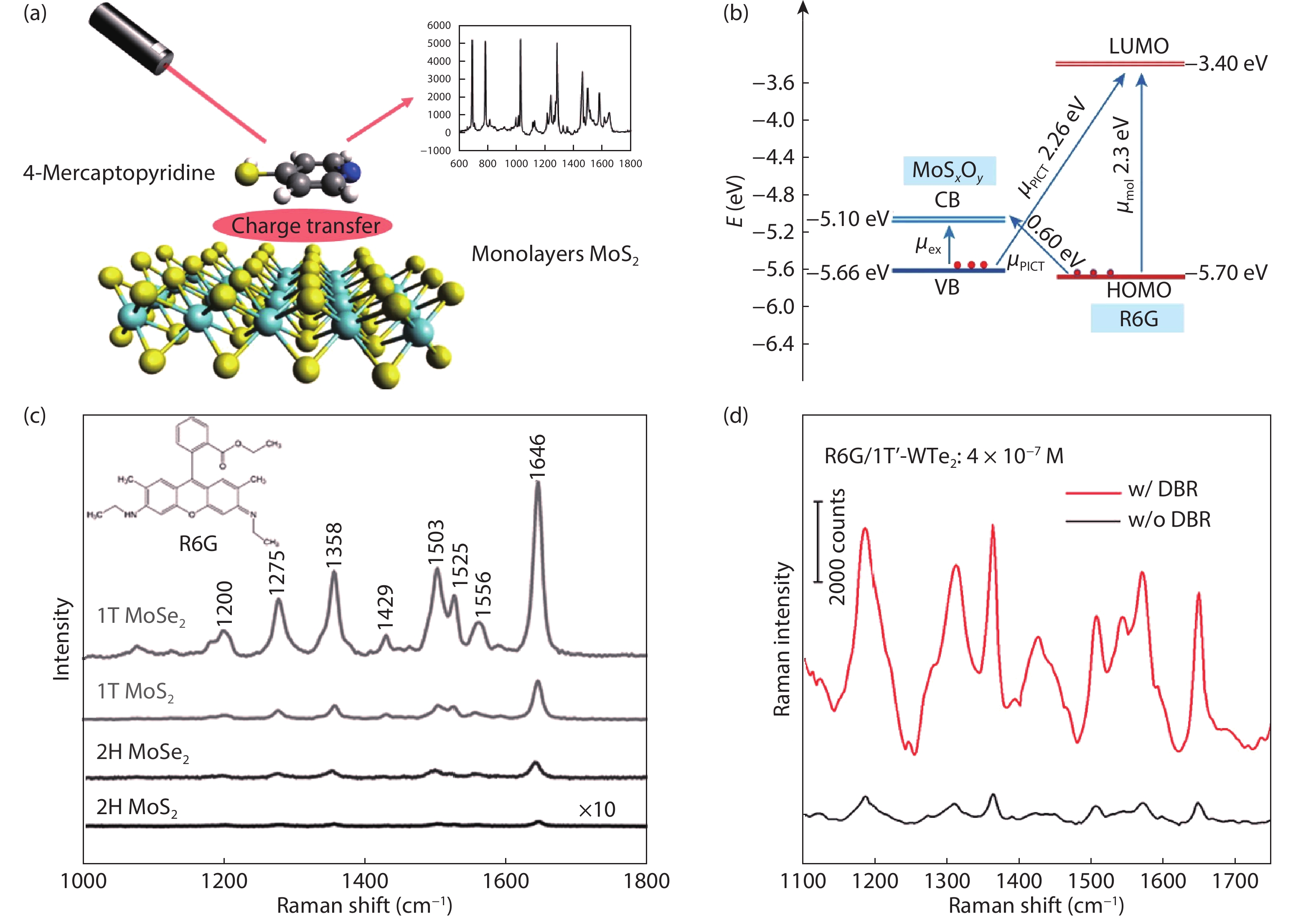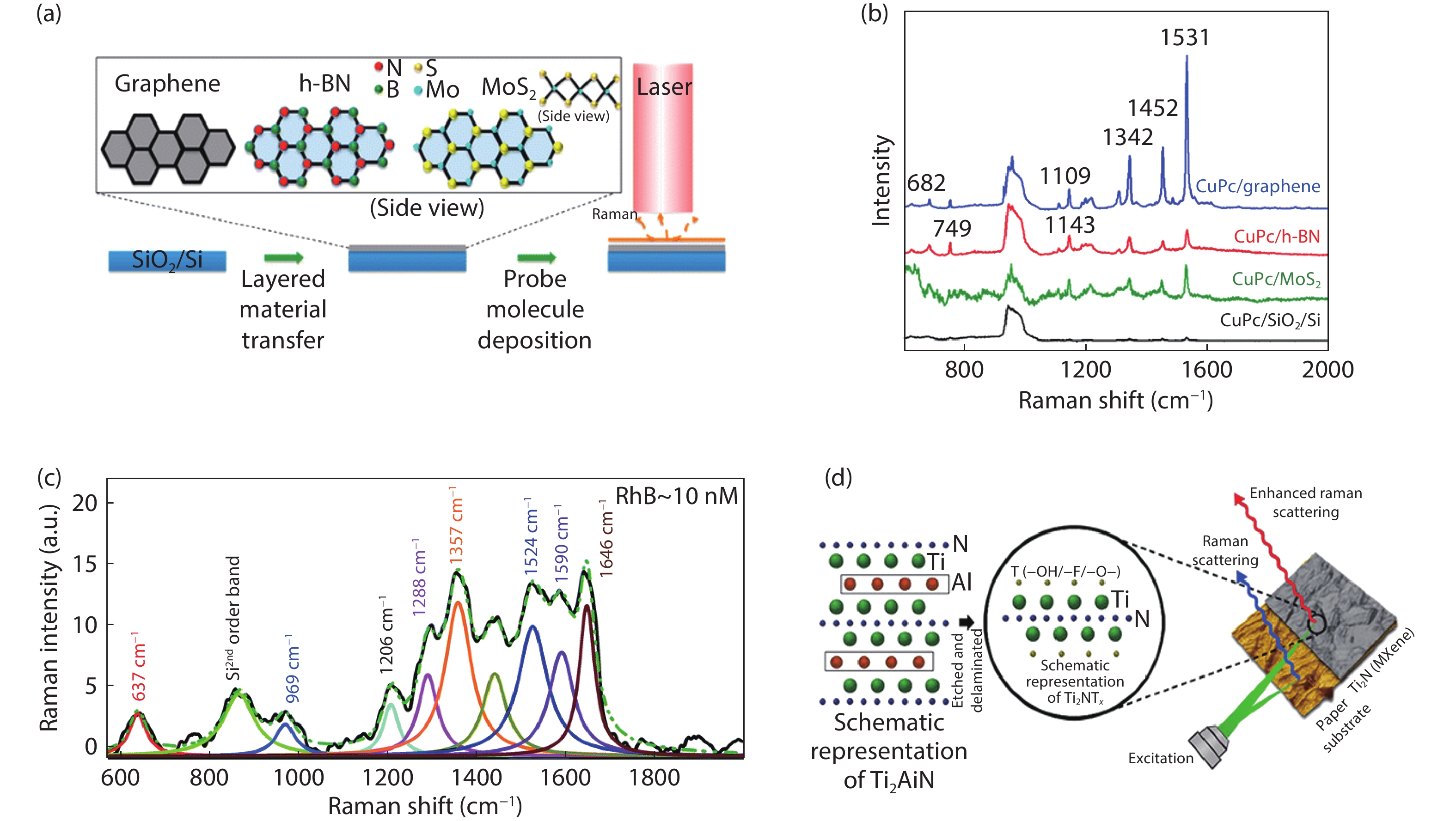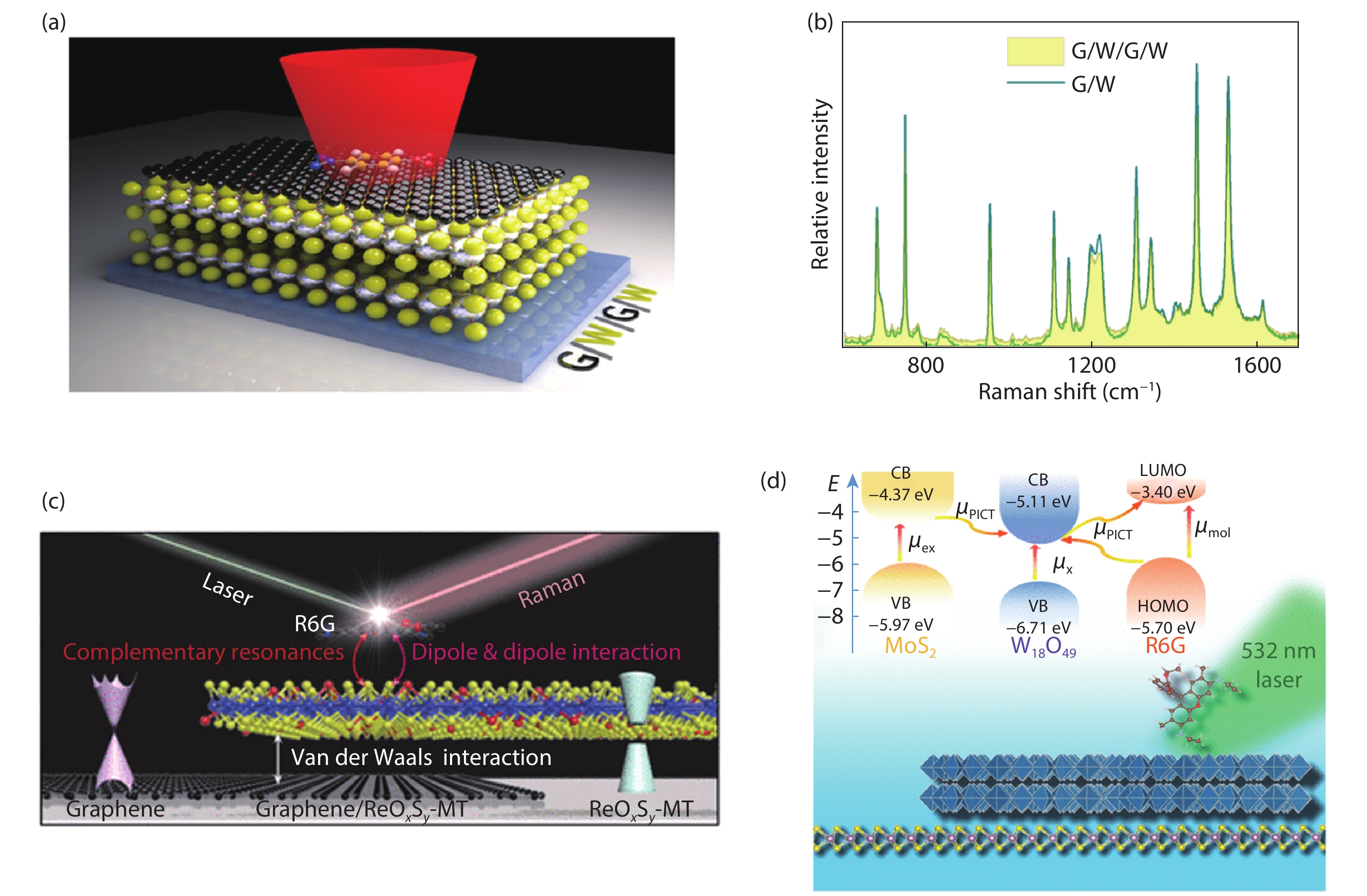| Citation: |
Enqing Zhang, Zhengkun Xing, Dian Wan, Haoran Gao, Yingdong Han, Yisheng Gao, Haofeng Hu, Zhenzhou Cheng, Tiegen Liu. Surface-enhanced Raman spectroscopy chips based on two-dimensional materials beyond graphene[J]. Journal of Semiconductors, 2021, 42(5): 051001. doi: 10.1088/1674-4926/42/5/051001
E Q Zhang, Z K Xing, D Wan, H R Gao, Y D Han, Y S Gao, H F Hu, Z Z Cheng, T G Liu, Surface-enhanced Raman spectroscopy chips based on two-dimensional materials beyond graphene[J]. J. Semicond., 2021, 42(5): 051001. doi: 10.1088/1674-4926/42/5/051001.
Export: BibTex EndNote
|
Surface-enhanced Raman spectroscopy chips based on two-dimensional materials beyond graphene
doi: 10.1088/1674-4926/42/5/051001
More Information-
Abstract
Surface-enhanced Raman spectroscopy (SERS) based on two-dimensional (2D) materials has attracted great attention over the past decade. Compared with metallic materials, which enhance Raman signals via the surface plasmon effect, 2D materials integrated on silicon substrates are ideal for use in the fabrication of plasmon-free SERS chips, with the advantages of outstanding fluorescence quenching capability, excellent biomolecular compatibility, tunable Fermi levels, and potentially low-cost material preparation. Moreover, recent studies have shown that the limits of detection of 2D-material-based SERS may be comparable with those of metallic substrates, which has aroused significant research interest. In this review, we comprehensively summarize the advances in SERS chips based on 2D materials. As several excellent reviews of graphene-enhanced Raman spectroscopy have been published in the past decade, here, we focus only on 2D materials beyond graphene, i.e., transition metal dichalcogenides, black phosphorus, hexagonal boron nitride, 2D titanium carbide or nitride, and their heterostructures. We hope that this paper can serve as a useful reference for researchers specializing in 2D materials, spectroscopy, and diverse applications related to chemical and biological sensing. -
References
[1] Fleischmann M, Hendra P J, McQuillan A J. Raman spectra of pyridine adsorbed at a silver electrode. Chem Phys Lett, 1974, 26, 163 doi: 10.1016/0009-2614(74)85388-1[2] Chen N, Xiao T H, Luo Z, et al. Porous carbon nanowire array for surface-enhanced Raman spectroscopy. Nat Commun, 2020, 11, 4772 doi: 10.1038/s41467-020-18590-7[3] Wei X P, Su S, Guo Y Y, et al. A molecular beacon-based signal-off surface-enhanced Raman scattering strategy for highly sensitive, reproducible, and multiplexed DNA detection. Small, 2013, 9, 2493 doi: 10.1002/smll.201202914[4] Srichan C, Ekpanyapong M, Horprathum M, et al. Highly-sensitive surface-enhanced Raman spectroscopy (SERS)-based chemical sensor using 3D graphene foam decorated with silver nanoparticles as SERS substrate. Sci Rep, 2016, 6, 23733 doi: 10.1038/srep23733[5] Campion A, Kambhampati P. Surface-enhanced Raman scattering. Chem Soc Rev, 1998, 27, 241 doi: 10.1039/a827241z[6] Shan Y F, Zheng Z H, Liu J J, et al. Niobium pentoxide: A promising surface-enhanced Raman scattering active semiconductor substrate. npj Comput Mater, 2017, 3, 11 doi: 10.1038/s41524-017-0008-0[7] Ding S Y, Yi J, Li J F, et al. Nanostructure-based plasmon-enhanced Raman spectroscopy for surface analysis of materials. Nat Rev Mater, 2016, 1, 16021 doi: 10.1038/natrevmats.2016.21[8] Pieczonka N P, Aroca R F. Single molecule analysis by surfaced-enhanced Raman scattering. Chem Soc Rev, 2008, 37, 946 doi: 10.1039/b709739p[9] Haldavnekar R, Venkatakrishnan K, Tan B. Non plasmonic semiconductor quantum SERS probe as a pathway for in vitro cancer detection. Nat Commun, 2018, 9, 3065 doi: 10.1038/s41467-018-05237-x[10] Rickard J J S, Di-Pietro V, Smith D J, et al. Rapid optofluidic detection of biomarkers for traumatic brain injury via surface-enhanced Raman spectroscopy. Nat Biomed Eng, 2020, 4, 610 doi: 10.1038/s41551-019-0510-4[11] Fraser J P, Postnikov P, Miliutina E, et al. Application of a 2D molybdenum telluride in SERS detection of biorelevant molecules. ACS Appl Mater Interfaces, 2020, 12, 47774 doi: 10.1021/acsami.0c11231[12] Pham T B, Hoang T H C, Pham V H, et al. Detection of Permethrin pesticide using silver nano-dendrites SERS on optical fibre fabricated by laser-assisted photochemical method. Sci Rep, 2019, 9, 12590 doi: 10.1038/s41598-019-49077-1[13] Shi G C, Wang M L, Zhu Y Y, et al. Dragonfly wing decorated by gold nanoislands as flexible and stable substrates for surface-enhanced Raman scattering (SERS). Sci Rep, 2018, 8, 6916 doi: 10.1038/s41598-018-25228-8[14] Satheeshkumar E, Makaryan T, Melikyan A, et al. One-step solution processing of Ag, Au and Pd@MXene hybrids for SERS. Sci Rep, 2016, 6, 32049 doi: 10.1038/srep32049[15] Campion A, Ivanecky J E III, Child C M, et al. On the mechanism of chemical enhancement in surface-enhanced Raman scattering. J Am Chem Soc, 1995, 117, 11807 doi: 10.1021/ja00152a024[16] Tan Y, Ma L N, Gao Z B, et al. Two-dimensional heterostructure as a platform for surface-enhanced Raman scattering. Nano Lett, 2017, 17, 2621 doi: 10.1021/acs.nanolett.7b00412[17] Feng S, Dos Santos M C, Carvalho B R, et al. Ultrasensitive molecular sensor using N-doped graphene through enhanced Raman scattering. Sci Adv, 2016, 2, e1600322 doi: 10.1126/sciadv.1600322[18] Yang M, Alvarez-Puebla R, Kim H S, et al. SERS-active gold lace nanoshells with built-in hotspots. Nano Lett, 2010, 10, 4013 doi: 10.1021/nl101946c[19] Karthick Kannan P, Shankar P, Blackman C, et al. Recent advances in 2D inorganic nanomaterials for SERS sensing. Adv Mater, 2019, 31, 1803432 doi: 10.1002/adma.201803432[20] Kleinman S L, Sharma B, Blaber M G, et al. Structure enhancement factor relationships in single gold nanoantennas by surface-enhanced Raman excitation spectroscopy. J Am Chem Soc, 2013, 135, 301 doi: 10.1021/ja309300d[21] Wustholz K L, Henry A I, McMahon J M, et al. Structure–activity relationships in gold nanoparticle dimers and trimers for surface-enhanced Raman spectroscopy. J Am Chem Soc, 2010, 132, 10903 doi: 10.1021/ja104174m[22] Maher R C, Cohen L F, Le Ru E C, et al. A study of local heating of molecules under surface enhanced Raman scattering (SERS) conditions using the anti-Stokes/Stokes ratio. Faraday Discuss, 2006, 132, 77 doi: 10.1039/B510413K[23] Schatz G C, Young M A, Duyne R P. Electromagnetic mechanism of SERS. Springer, 2006[24] Kim J, Jang Y, Kim N J, et al. Study of chemical enhancement mechanism in non-plasmonic surface enhanced Raman spectroscopy (SERS). Front Chem, 2019, 7, 582 doi: 10.3389/fchem.2019.00582[25] Ling X, Moura L G, Pimenta M A, et al. Charge-transfer mechanism in graphene-enhanced Raman scattering. J Phys Chem C, 2012, 116, 25112 doi: 10.1021/jp3088447[26] Ling X, Wu J X, Xu W G, et al. Probing the effect of molecular orientation on the intensity of chemical enhancement using graphene-enhanced Raman spectroscopy. Small, 2012, 8, 1365 doi: 10.1002/smll.201102223[27] Lin J, Shang Y, Li X X, et al. Ultrasensitive SERS detection by defect engineering on single Cu2O superstructure particle. Adv Mater, 2017, 29, 1604797 doi: 10.1002/adma.201604797[28] Osawa M, Matsuda N, Yoshii K, et al. Charge transfer resonance Raman process in surface-enhanced Raman scattering from p-aminothiophenol adsorbed on silver: Herzberg-Teller contribution. J Phys Chem, 1994, 98, 12702 doi: 10.1021/j100099a038[29] Alessandri I, Lombardi J R. Enhanced Raman scattering with dielectrics. Chem Rev, 2016, 116, 14921 doi: 10.1021/acs.chemrev.6b00365[30] Lombardi J R, Birke R L. Theory of surface-enhanced Raman scattering in semiconductors. J Phys Chem C, 2014, 118, 11120 doi: 10.1021/jp5020675[31] Saleh T A, Al-Shalalfeh M M, Al-Saadi A A. Silver loaded graphene as a substrate for sensing 2-thiouracil using surface-enhanced Raman scattering. Sensor Actuat B, 2018, 254, 1110 doi: 10.1016/j.snb.2017.07.179[32] Jiang C X, Wei Y Q, Zhao P C, et al. Investigation of surface-enhanced Raman spectroscopy on the substrates of telluride 2D material. Eur Phys J Plus, 2020, 135, 671 doi: 10.1140/epjp/s13360-020-00688-y[33] Kitadai H, Wang X Z, Mao N N, et al. Enhanced Raman scattering on nine 2D van der waals materials. J Phys Chem Lett, 2019, 10, 3043 doi: 10.1021/acs.jpclett.9b01146[34] Li W W, Xiong L, Li N C, et al. Tunable 3D light trapping architectures based on self-assembled SnSe2 nanoplate arrays for ultrasensitive SERS detection. J Mater Chem C, 2019, 7, 10179 doi: 10.1039/C9TC03715B[35] Manzeli S, Ovchinnikov D, Pasquier D, et al. 2D transition metal dichalcogenides. Nat Rev Mater, 2017, 2, 1 doi: 10.1038/natrevmats.2017.33[36] Song X J, Wang Y, Zhao F, et al. Plasmon-free surface-enhanced Raman spectroscopy using metallic 2D materials. ACS Nano, 2019, 13, 8312 doi: 10.1021/acsnano.9b03761[37] Zhang N, Lin J J, Zhang S Q, et al. Doping modulated in-plane anisotropic Raman enhancement on layered ReS2. Nano Res, 2019, 12, 563 doi: 10.1007/s12274-018-2254-y[38] Chen M P, Liu D, Du X Y, et al. 2D materials: Excellent substrates for surface-enhanced Raman scattering (SERS) in chemical sensing and biosensing. Trac Trends Anal Chem, 2020, 130, 115983 doi: 10.1016/j.trac.2020.115983[39] Mak K F, Shan J. Photonics and optoelectronics of 2D semiconductor transition metal dichalcogenides. Nat Photonics, 2016, 10, 216 doi: 10.1038/nphoton.2015.282[40] Lee Y, Kim H, Lee J, et al. Enhanced Raman scattering of rhodamine 6G films on two-dimensional transition metal dichalcogenides correlated to photoinduced charge transfer. Chem Mater, 2016, 28, 180 doi: 10.1021/acs.chemmater.5b03714[41] Li H, Zhang Q, Yap C C R, et al. From bulk to monolayer MoS2: Evolution of Raman scattering. Adv Funct Mater, 2012, 22, 1385 doi: 10.1002/adfm.201102111[42] Li Z, Jiang S Z, Xu S C, et al. Facile synthesis of large-area and highly crystalline WS2 film on dielectric surfaces for SERS. J Alloy Compd, 2016, 666, 412 doi: 10.1016/j.jallcom.2016.01.126[43] Liu Y R, Gao Z B, Chen M, et al. Enhanced Raman scattering of CuPc films on imperfect WSe2 monolayer correlated to exciton and charge-transfer resonances. Adv Funct Mater, 2018, 28, 1805710 doi: 10.1002/adfm.201805710[44] Lu Z Y, Si H P, Li Z, et al. Sensitive, reproducible, and stable 3D plasmonic hybrids with bilayer WS2 as nanospacer for SERS analysis. Opt Express, 2018, 26, 21626 doi: 10.1364/OE.26.021626[45] Meng L, Hu S, Xu C J, et al. Surface enhanced Raman effect on CVD growth of WS2 film. Chem Phys Lett, 2018, 707, 71 doi: 10.1016/j.cplett.2018.07.040[46] Miao P, Qin J K, Shen Y F, et al. Unraveling the Raman enhancement mechanism on 1T'-phase ReS2 nanosheets. Small, 2018, 14, 1704079 doi: 10.1002/smll.201704079[47] Shutov A D, Yi Z H, Wang J Z, et al. Giant chemical surface enhancement of coherent Raman scattering on MoS2. ACS Photonics, 2018, 5, 4960 doi: 10.1021/acsphotonics.8b01136[48] Xu Y Y, Yang C, Jiang S Z, et al. Layer-controlled large area MoS2 layers grown on mica substrate for surface-enhanced Raman scattering. Appl Surf Sci, 2015, 357, 1708 doi: 10.1016/j.apsusc.2015.10.032[49] Zheng G, Zhang P, Zhang S W, et al. SERS effect of selectively adsorbed dyes by hydrothermally-produced MoS2 nanosheets. New J Chem, 2018, 42, 18906 doi: 10.1039/C8NJ03837F[50] Muehlethaler C, Considine C R, Menon V, et al. Ultrahigh Raman enhancement on monolayer MoS2. ACS Photonics, 2016, 3, 1164 doi: 10.1021/acsphotonics.6b00213[51] Sun L F, Hu H L, Zhan D, et al. Plasma modified MoS2 nanoflakes for surface enhanced Raman scattering. Small, 2014, 10, 1090 doi: 10.1002/smll.201300798[52] Zuo P, Jiang L, Li X, et al. Enhancing charge transfer with foreign molecules through femtosecond laser induced MoS2 defect sites for photoluminescence control and SERS enhancement. Nanoscale, 2019, 11, 485 doi: 10.1039/C8NR08785G[53] Zheng Z, Cong S, Gong W, et al. Semiconductor SERS enhancement enabled by oxygen incorporation. Nat Commun, 2017, 8, 1993 doi: 10.1038/s41467-017-02166-z[54] Hou X, Lin Q, Wei Y, et al. Surface-enhanced Raman scattering monitoring of oxidation states in defect-engineered two-dimensional transition metal dichalcogenides. J Phys Chem Lett, 2020, 11, 7981 doi: 10.1021/acs.jpclett.0c02318[55] Chen M P, Ji B, Dai Z Y, et al. Vertically-aligned 1T/2H-MS2 (M = Mo, W) nanosheets for surface-enhanced Raman scattering with long-term stability and large-scale uniformity. Appl Surf Sci, 2020, 527, 146769 doi: 10.1016/j.apsusc.2020.146769[56] Er E, Hou H L, Criado A, et al. High-yield preparation of exfoliated 1T-MoS2 with SERS activity. Chem Mater, 2019, 31, 5725 doi: 10.1021/acs.chemmater.9b01698[57] Yin Y, Miao P, Zhang Y M, et al. Significantly increased Raman enhancement on MoX2 (X = S, Se) monolayers upon phase transition. Adv Funct Mater, 2017, 27, 1606694 doi: 10.1002/adfm.201606694[58] Tao L, Chen K, Chen Z, et al. 1T′ transition metal telluride atomic layers for plasmon-free SERS at femtomolar levels. J Am Chem Soc, 2018, 140, 8696 doi: 10.1021/jacs.8b02972[59] Zhang K L, Feng Y L, Wang F, et al. Two dimensional hexagonal boron nitride (2D-hBN): Synthesis, properties and applications. J Mater Chem C, 2017, 5, 11992 doi: 10.1039/C7TC04300G[60] Giovannetti G, Khomyakov P A, Brocks G, et al. Substrate-induced band gap in graphene on hexagonal boron nitride: Ab initiodensity functional calculations. Phys Rev B, 2007, 76, 073103 doi: 10.1103/PhysRevB.76.073103[61] Li J, Majety S, Dahal R, et al. Dielectric strength, optical absorption, and deep ultraviolet detectors of hexagonal boron nitride epilayers. Appl Phys Lett, 2012, 101, 171112 doi: 10.1063/1.4764533[62] Novoselov K S, Geim A K, Morozov S V, et al. Two-dimensional gas of massless Dirac fermions in graphene. Nature, 2005, 438, 197 doi: 10.1038/nature04233[63] Bao J, Edwards M, Huang S R, et al. Two-dimensional hexagonal boron nitride as lateral heat spreader in electrically insulating packaging. J Phys D, 2016, 49, 265501 doi: 10.1088/0022-3727/49/26/265501[64] Chimene D, Alge D L, Gaharwar A K. Two-dimensional nanomaterials for biomedical applications: Emerging trends and future prospects. Adv Mater, 2015, 27, 7261 doi: 10.1002/adma.201502422[65] Wang J G, Ma F C, Liang W J, et al. Optical, photonic and optoelectronic properties of graphene, h-BN and their hybrid materials. Nanophotonics, 2017, 6, 943 doi: 10.1515/nanoph-2017-0015[66] Cai Q R, Mateti S, Yang W R, et al. Boron nitride nanosheets improve sensitivity and reusability of surface-enhanced Raman spectroscopy. Angew Chem, 2016, 128, 8545 doi: 10.1002/ange.201600517[67] Chugh D, Jagadish C, Tan H. Large-area hexagonal boron nitride for surface enhanced Raman spectroscopy. Adv Mater Technol, 2019, 4, 1900220 doi: 10.1002/admt.201900220[68] Ling X, Fang W J, Lee Y H, et al. Raman enhancement effect on two-dimensional layered materials: Graphene, h-BN and MoS2. Nano Lett, 2014, 14, 3033 doi: 10.1021/nl404610c[69] Liu J, Zheng T T, Tian Y. Functionalized h-BN nanosheets as a theranostic platform for SERS real-time monitoring of MicroRNA and photodynamic therapy. Angew Chem Int Ed, 2019, 58, 7757 doi: 10.1002/anie.201902776[70] Xia F N, Wang H, Jia Y C. Rediscovering black phosphorus as an anisotropic layered material for optoelectronics and electronics. Nat Commun, 2014, 5, 4458 doi: 10.1038/ncomms5458[71] Cho S Y, Lee Y, Koh H J, et al. Superior chemical sensing performance of black phosphorus: Comparison with MoS2 and graphene. Adv Mater, 2016, 28, 7020 doi: 10.1002/adma.201601167[72] Ling X, Zhang J. First-layer effect in graphene-enhanced Raman scattering. Small, 2010, 6, 2020 doi: 10.1002/smll.201000918[73] Guo Z N, Zhang H, Lu S B, et al. From black phosphorus to phosphorene: Basic solvent exfoliation, evolution of Raman scattering, and applications to ultrafast photonics. Adv Funct Mater, 2015, 25, 6996 doi: 10.1002/adfm.201502902[74] Kim J, Lee J U, Lee J, et al. Correction: Anomalous polarization dependence of Raman scattering and crystallographic orientation of black phosphorus. Nanoscale, 2020, 12, 10407 doi: 10.1039/D0NR90098B[75] Liu S J, Huo N J, Gan S, et al. Thickness-dependent Raman spectra, transport properties and infrared photoresponse of few-layer black phosphorus. J Mater Chem C, 2015, 3, 10974 doi: 10.1039/C5TC01809A[76] Wang R, Yan X Y, Ge B C, et al. Facile preparation of self-assembled black phosphorus-dye composite films for chemical gas sensors and surface-enhanced Raman scattering performances. ACS Sustain Chem Eng, 2020, 8, 4521 doi: 10.1021/acssuschemeng.9b07840[77] Lu W L, Nan H Y, Hong J H, et al. Plasma-assisted fabrication of monolayer phosphorene and its Raman characterization. Nano Res, 2014, 7, 853 doi: 10.1007/s12274-014-0446-7[78] Liu X L, Wood J D, Chen K S, et al. In situ thermal decomposition of exfoliated two-dimensional black phosphorus. J Phys Chem Lett, 2015, 6, 773 doi: 10.1021/acs.jpclett.5b00043[79] Fortin-Deschênes M, Levesque P L, Martel R, et al. Dynamics and mechanisms of exfoliated black phosphorus sublimation. J Phys Chem Lett, 2016, 7, 1667 doi: 10.1021/acs.jpclett.6b00584[80] Kundu A, Rani R, Hazra K S. Controlled nanofabrication of metal-free SERS substrate on few layered black phosphorus by low power focused laser irradiation. Nanoscale, 2019, 11, 16245 doi: 10.1039/C9NR02615K[81] Chenet D A, Aslan O B, Huang P Y, et al. In-plane anisotropy in mono- and few-layer ReS2 probed by Raman spectroscopy and scanning transmission electron microscopy. Nano Lett, 2015, 15, 5667 doi: 10.1021/acs.nanolett.5b00910[82] Fei R X, Yang L. Strain-engineering the anisotropic electrical conductance of few-layer black phosphorus. Nano Lett, 2014, 14, 2884 doi: 10.1021/nl500935z[83] Wu J, Mao N, Xie L, et al. Identifying the crystalline orientation of black phosphorus using angle-resolved polarized Raman spectroscopy. Angew Chem Int Ed Engl, 2015, 54, 2366 doi: 10.1002/anie.201410108[84] Lin J J, Liang L B, Ling X, et al. Enhanced Raman scattering on in-plane anisotropic layered materials. J Am Chem Soc, 2015, 137, 15511 doi: 10.1021/jacs.5b10144[85] Huang K, Li Z, Lin J, et al. Two-dimensional transition metal carbides and nitrides (MXenes) for biomedical applications. Chem Soc Rev, 2018, 47, 5109 doi: 10.1039/C7CS00838D[86] Naguib M, Kurtoglu M, Presser V, et al. Two-dimensional nanocrystals produced by exfoliation of Ti3AlC2. Adv Mater, 2011, 23, 4248 doi: 10.1002/adma.201102306[87] Limbu T B, Chitara B, Orlando J D, et al. Green synthesis of reduced Ti3C2Tx MXene nanosheets with enhanced conductivity, oxidation stability, and SERS activity. J Mater Chem C, 2020, 8, 4722 doi: 10.1039/C9TC06984D[88] Liu R Y, Jiang L, Lu C X, et al. Large-scale two-dimensional titanium carbide MXene as SERS-active substrate for reliable and sensitive detection of organic pollutants. Spectrochim Acta A, 2020, 236, 118336 doi: 10.1016/j.saa.2020.118336[89] Wang H B, Zhang J F, Wu Y P, et al. Surface modified MXene Ti3C2 multilayers by aryl diazonium salts leading to large-scale delamination. Appl Surf Sci, 2016, 384, 287 doi: 10.1016/j.apsusc.2016.05.060[90] Ye Y T, Yi W C, Liu W, et al. Remarkable surface-enhanced Raman scattering of highly crystalline monolayer Ti3C2 nanosheets. Sci China Mater, 2020, 63, 794 doi: 10.1007/s40843-020-1283-8[91] Sarycheva A, Makaryan T, Maleski K, et al. Two-dimensional titanium carbide (MXene) as surface-enhanced Raman scattering substrate. J Phys Chem C, 2017, 121, 19983 doi: 10.1021/acs.jpcc.7b08180[92] Soundiraraju B, George B K. Two-dimensional titanium nitride (Ti2N) MXene: Synthesis, characterization, and potential application as surface-enhanced Raman scattering substrate. ACS Nano, 2017, 11, 8892 doi: 10.1021/acsnano.7b03129[93] Ling X, Xie L M, Fang Y, et al. Can graphene be used as a substrate for Raman enhancement. Nano Lett, 2010, 10, 553 doi: 10.1021/nl903414x[94] Qiu C Y, Zhou H Q, Yang H C, et al. Investigation of n-layer graphenes as substrates for Raman enhancement of crystal violet. J Phys Chem C, 2011, 115, 10019 doi: 10.1021/jp111617c[95] Georgiou T, Jalil R, Belle B D, et al. Vertical field-effect transistor based on graphene-WS2 heterostructures for flexible and transparent electronics. Nat Nanotechnol, 2013, 8, 100 doi: 10.1038/nnano.2012.224[96] Cai Q R, Gan W, Falin A, et al. Two-dimensional van der waals heterostructures for synergistically improved surface-enhanced Raman spectroscopy. ACS Appl Mater Interfaces, 2020, 12, 21985 doi: 10.1021/acsami.0c01157[97] Yola M L, Atar N. Simultaneous determination of β-agonists on hexagonal boron nitride nanosheets/multi-walled carbon nanotubes nanocomposite modified glassy carbon electrode. Mater Sci Eng C, 2019, 96, 669 doi: 10.1016/j.msec.2018.12.004[98] Ghopry S A, Alamri M A, Goul R, et al. Extraordinary sensitivity of surface-enhanced Raman spectroscopy of molecules on MoS2 (WS2) nanodomes/graphene van der Waals heterostructure substrates. Adv Opt Mater, 2019, 7, 1801249 doi: 10.1002/adom.201801249[99] Wu D, Chen J L, Ruan Y E, et al. A novel sensitive and stable surface enhanced Raman scattering substrate based on a MoS2 quantum dot/reduced graphene oxide hybrid system. J Mater Chem C, 2018, 6, 12547 doi: 10.1039/C8TC05151H[100] Qiu H W, Wang M Q, Zhang L, et al. Wrinkled 2H-phase MoS2 sheet decorated with graphene-microflowers for ultrasensitive molecular sensing by plasmon-free SERS enhancement. Sens Actuator B, 2020, 320, 128445 doi: 10.1016/j.snb.2020.128445[101] Seo J, Lee J, Kim Y, et al. Ultrasensitive plasmon-free surface-enhanced Raman spectroscopy with femtomolar detection limit from 2D van der waals heterostructure. Nano Lett, 2020, 20, 1620 doi: 10.1021/acs.nanolett.9b04645[102] Cong S, Yuan Y, Chen Z, et al. Noble metal-comparable SERS enhancement from semiconducting metal oxides by making oxygen vacancies. Nat Commun, 2015, 6, 7800 doi: 10.1038/ncomms8800[103] Musumeci A, Gosztola D, Schiller T, et al. SERS of semiconducting nanoparticles (TiO2 hybrid composites). J Am Chem Soc, 2009, 131, 6040 doi: 10.1021/ja808277u[104] Li M Z, Fan X C, Gao Y M, et al. W18O49/monolayer MoS2 heterojunction-enhanced Raman scattering. J Phys Chem Lett, 2019, 10, 4038 doi: 10.1021/acs.jpclett.9b00972[105] Xie L M, Ling X, Fang Y, et al. Graphene as a substrate to suppress fluorescence in resonance Raman spectroscopy. J Am Chem Soc, 2009, 131, 9890 doi: 10.1021/ja9037593[106] Xu H, Xie L M, Zhang H L, et al. Effect of graphene fermi level on the Raman scattering intensity of molecules on graphene. ACS Nano, 2011, 5, 5338 doi: 10.1021/nn103237x[107] Xu W, Ling X, Xiao J, et al. Surface enhanced Raman spectroscopy on a flat graphene surface. PNAS, 2012, 109, 9281 doi: 10.1073/pnas.1205478109[108] Xu W G, Mao N N, Zhang J. Graphene: A platform for surface-enhanced Raman spectroscopy. Small, 2013, 9, 1206 doi: 10.1002/smll.201203097[109] Kuo C C, Chen C H. Graphene thickness-controlled photocatalysis and surface enhanced Raman scattering. Nanoscale, 2014, 6, 12805 doi: 10.1039/C4NR03877K[110] Kim H, Seol M L, Lee D I, et al. Single nanowire on graphene (SNOG) as an efficient, reproducible, and stable SERS-active platform. Nanoscale, 2016, 8, 8878 doi: 10.1039/C6NR00092D[111] Huang S X, Pandey R, Barman I, et al. Raman enhancement of blood constituent proteins using graphene. ACS Photonics, 2018, 5, 2978 doi: 10.1021/acsphotonics.8b00456[112] Silver A, Kitadai H, Liu H, et al. Chemical and bio sensing using graphene-enhanced Raman spectroscopy. Nanomaterials, 2019, 9, 516 doi: 10.3390/nano9040516[113] Hou X Y, Zhang X Y, Ma Q W, et al. Alloy engineering in few-layer manganese phosphorus trichalcogenides for surface-enhanced Raman scattering. Adv Funct Mater, 2020, 30, 1910171 doi: 10.1002/adfm.201910171[114] Wang X T, Shi W X, Wang S X, et al. Two-dimensional amorphous TiO2 nanosheets enabling high-efficiency photoinduced charge transfer for excellent SERS activity. J Am Chem Soc, 2019, 141, 5856 doi: 10.1021/jacs.9b00029[115] Lee M R, Lee H K, Yang Y, et al. Direct metal writing and precise positioning of gold nanoparticles within microfluidic channels for SERS sensing of gaseous analytes. ACS Appl Mater Interfaces, 2017, 9, 39584 doi: 10.1021/acsami.7b11649[116] Oh Y J, Jeong K H. Optofluidic SERS chip with plasmonic nanoprobes self-aligned along microfluidic channels. Lab Chip, 2014, 14, 865 doi: 10.1039/c3lc51257f[117] Cheng Z Z, Tsang H K, Wang X M, et al. In-plane optical absorption and free carrier absorption in graphene-on-silicon waveguides. IEEE J Sel Top Quantum Electron, 2014, 20, 43 doi: 10.1109/JSTQE.2013.2263115[118] Wang J Q, Cheng Z Z, Shu C, et al. Optical absorption in graphene-on-silicon nitride microring resonators. IEEE Photonics Technol Lett, 2015, 27, 1765 doi: 10.1109/LPT.2015.2443051 -
Proportional views





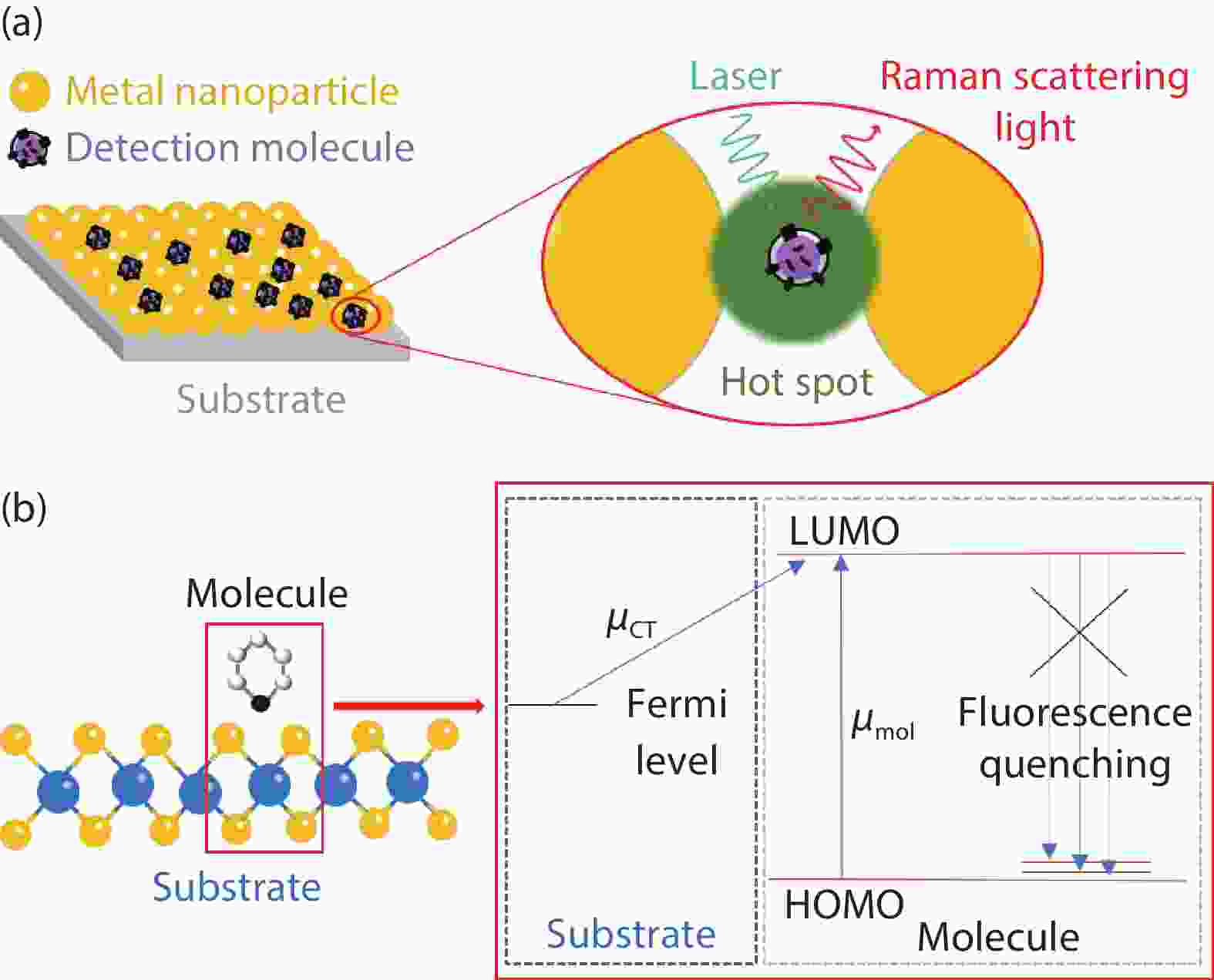
 DownLoad:
DownLoad:
